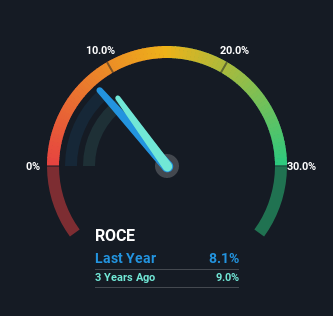- India
- /
- Auto Components
- /
- NSEI:MUNJALAU
The Returns On Capital At Munjal Auto Industries (NSE:MUNJALAU) Don't Inspire Confidence
Finding a business that has the potential to grow substantially is not easy, but it is possible if we look at a few key financial metrics. Amongst other things, we'll want to see two things; firstly, a growing return on capital employed (ROCE) and secondly, an expansion in the company's amount of capital employed. This shows us that it's a compounding machine, able to continually reinvest its earnings back into the business and generate higher returns. In light of that, when we looked at Munjal Auto Industries (NSE:MUNJALAU) and its ROCE trend, we weren't exactly thrilled.
Return On Capital Employed (ROCE): What Is It?
Just to clarify if you're unsure, ROCE is a metric for evaluating how much pre-tax income (in percentage terms) a company earns on the capital invested in its business. Analysts use this formula to calculate it for Munjal Auto Industries:
Return on Capital Employed = Earnings Before Interest and Tax (EBIT) ÷ (Total Assets - Current Liabilities)
0.081 = ₹526m ÷ (₹12b - ₹5.6b) (Based on the trailing twelve months to September 2022).
So, Munjal Auto Industries has an ROCE of 8.1%. Ultimately, that's a low return and it under-performs the Auto Components industry average of 13%.
View our latest analysis for Munjal Auto Industries

While the past is not representative of the future, it can be helpful to know how a company has performed historically, which is why we have this chart above. If you're interested in investigating Munjal Auto Industries' past further, check out this free graph of past earnings, revenue and cash flow.
What Can We Tell From Munjal Auto Industries' ROCE Trend?
On the surface, the trend of ROCE at Munjal Auto Industries doesn't inspire confidence. Over the last five years, returns on capital have decreased to 8.1% from 17% five years ago. Given the business is employing more capital while revenue has slipped, this is a bit concerning. This could mean that the business is losing its competitive advantage or market share, because while more money is being put into ventures, it's actually producing a lower return - "less bang for their buck" per se.
On a side note, Munjal Auto Industries' current liabilities are still rather high at 46% of total assets. This can bring about some risks because the company is basically operating with a rather large reliance on its suppliers or other sorts of short-term creditors. Ideally we'd like to see this reduce as that would mean fewer obligations bearing risks.
What We Can Learn From Munjal Auto Industries' ROCE
In summary, we're somewhat concerned by Munjal Auto Industries' diminishing returns on increasing amounts of capital. Investors haven't taken kindly to these developments, since the stock has declined 43% from where it was five years ago. That being the case, unless the underlying trends revert to a more positive trajectory, we'd consider looking elsewhere.
One more thing to note, we've identified 3 warning signs with Munjal Auto Industries and understanding these should be part of your investment process.
While Munjal Auto Industries isn't earning the highest return, check out this free list of companies that are earning high returns on equity with solid balance sheets.
New: Manage All Your Stock Portfolios in One Place
We've created the ultimate portfolio companion for stock investors, and it's free.
• Connect an unlimited number of Portfolios and see your total in one currency
• Be alerted to new Warning Signs or Risks via email or mobile
• Track the Fair Value of your stocks
Have feedback on this article? Concerned about the content? Get in touch with us directly. Alternatively, email editorial-team (at) simplywallst.com.
This article by Simply Wall St is general in nature. We provide commentary based on historical data and analyst forecasts only using an unbiased methodology and our articles are not intended to be financial advice. It does not constitute a recommendation to buy or sell any stock, and does not take account of your objectives, or your financial situation. We aim to bring you long-term focused analysis driven by fundamental data. Note that our analysis may not factor in the latest price-sensitive company announcements or qualitative material. Simply Wall St has no position in any stocks mentioned.
About NSEI:MUNJALAU
Munjal Auto Industries
Manufactures and sells auto components for motor vehicles in India.
Low risk and slightly overvalued.
Market Insights
Community Narratives



